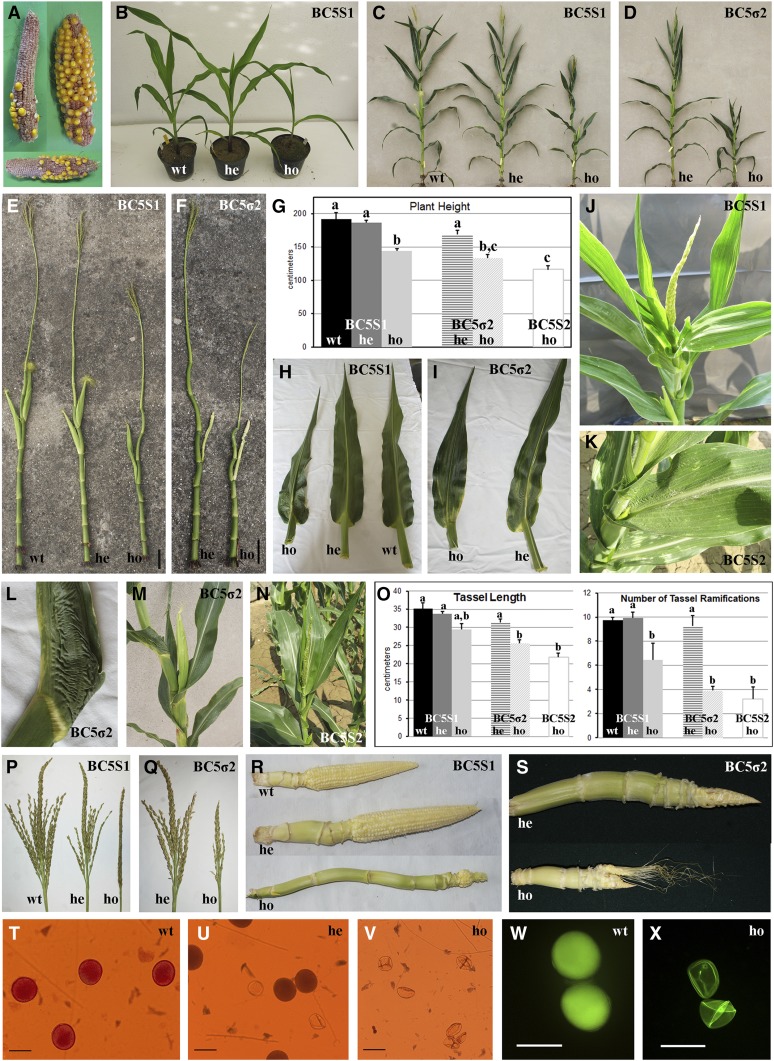Figure 2.
Knockout of HDA108 expression induces developmental defects in maize vegetative and reproductive organs. (A) Reduced fertility of cobs produced by self-pollination of BC5 plants. (B and C) Wild-type (wt), heterozygous (he), and homozygous (ho) plants, respectively, for the hda108 mutated allele at the V5 stage grown in the greenhouse (B) and at flowering in the field (C) belonging to BC5S1 progeny. (D) BC5σ2 heterozygous and homozygous plants grown in the field. Homozygous BC5σ2 plants are smaller than heterozygous plants of the same segregating progeny. (E and F) Comparison of stalks of different genotypes of BC5S1 (E) and B5σ2 (F) after complete removal of leaf sheaths revealed a reduction of node number and internode length in hda108 mutants, accompanied by stalk curvatures. These defects are more evident in B5σ2 progenies, in both heterozygous and homozygous plants. Bar, 10 cm. (G) Histograms of plant height at flowering in different genotypes and progenies; bars represent SE. Data were collected from at least eight plants per genotype during the field trial in 2013. Different letters indicate means with significant difference (P < 0.05; Tukey’s test). (H–N) In BC5S1 homozygous and BC5σ2 heterozygous and homozygous plants, the hda108 mutation resulted in leaf blade reduction (H and I), leaf twisting (J and M), leaf knots and wrinkles (L), and disorganized differentiation of the blade–sheath boundary (H and I). The plant and leaf phenotypes are even more altered in BC5S2 mutant homozygous plants (K and N). (O) Histograms of tassel length and number of tassel ramifications in different genotypes and progenies. Data were collected from at least eight tassels per genotype during the field trial in 2013. Bars represent SE and different letters indicate significantly different means (P < 0.05; Tukey’s test). (P) Tassels of wild-type, heterozygous, and homozygous plants of BC5S1 progeny in which the reduction in number of ramifications is evident comparing the different genotypes. (Q) Tassels of heterozygous and homozygous BC5σ2. (R) Ears of wild-type, heterozygous, and homozygous plants of BC5S1 progeny: in homozygous mutant plants the ear does not differentiate along the axis. (S) Ear of heterozygous and homozygous BC5σ2 with evident developmental defects and displaced tissues. (T–X) Microscope images of mature pollen collected from wild-type (T and W), heterozygous (U), and homozygous mutant (V and X) BC5S1 plants. In homozygous plants the pollen grains are shrunken, collapsed, do not stain with carminic acid, and present reduced autofluorescence (V and X), while the heterozygous genotypes produce ∼50% of shrunken pollen (U). Bar, 100 µm.

